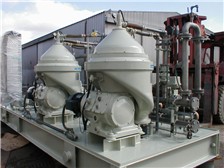by JAMES FINCH
As reported by the Wall Street Journal, Sunday night’s revelations that China National Nuclear Corp (CNNC) may strengthen its ties to UraMin
There is an ongoing global war for energy security, which appears to be politically inspired. China and Russia are the main opponents, especially in Africa, but have rivaled each other, over the past several years, in Central Asia. The goal for both nations is not only energy security but political influence and alliance over their targeted territories.
On May 12th, Russia, Kazakhstan and Turkmenistan signed a declaration to upgrade and expand transport pipelines along the Caspian Sea coast directly to Russia. The project relies mainly upon the vast Turkmen gas reserves. This is part of Russia’s growing monopoly of Central Asian gas. Although Europe was shocked by Vladimir Putin’s new arrangement, the Chinese were flabbergasted.
We’ve been following developments in Central Asia, and had reported upon milestone events in both of our uranium publications, and again (with far greater details) in our soon-to-be-released Investing in China’s Energy Crisis.
After more than two decades in power, Turkmen strongman Saparmurat Niyazov passed away this past December. In April 2006, Niyazov had signed a framework agreement on oil and gas cooperation. By August, Niyazov had announced a pipeline, designed to pump gas to China, would be opened in 2009. The deal died with the dictator, it appears.
A few weeks ago, a spokesman for China’s National Reform and Development Committee announced China was unlikely to reach its natural gas target of a 10-percent portion of the country’s energy portfolio by 2010. Increasingly, Russia has shut China out of Central Asia in obtaining long-term, multiple energy sources.
Aside from South America, where China has strengthened the country’s ties with Venezuela and others, Africa is a prime hunting ground for China’s future energy security. China has established a strong foothold in the Sudan for petroleum. But, Africa is rich in uranium deposits.
According to a report published by the International Atomic Energy Agency in 2005, Africa has 18 percent of the world’s known recoverable uranium resources – about six percent less than Australia and one percent more than Kazakhstan. We began coverage on both Namibia and Niger, after Russia sent a delegation to Egypt to discuss the nuclear renaissance. At the time, our research pointed to Africa, particularly those countries, as ripe for future uranium production. Chinese prospectors raced to Niger within weeks after our initial coverage.
During 2006, Namibia became saturated with numerous exploration plays hoping to capitalize on the country’s uranium resources and relaxed environment. Consequently, the Namibian Minister of Mines and Energy closed the country’s exploration window. Since then, Niger has become a new hunting ground. We expect this country to become just as saturated as Namibia has been.
China is eager to capitalize upon the continent’s uranium resources before Russia outmaneuvers them as has been accomplished in Central Asia.
According to an email we received from TradeTech’s Gene Clark, after presenting at the China Power & Alternative Energy Summit on May 18th, he told us China’s official target for nuclear power capacity was ‘40 GWe by 2020 and another 18 GWe in the following five-year plan.’ This confirms China’s aggressive plans to acquire sufficient uranium to reach this capacity, and would be foolish to rely on just Australia.
Typically, China has built its energy portfolio through numerous deals across multiple regions. This past October, Yang Changli, vice president of China National Nuclear, said it would seek uranium not only from Australia, but from Canada, Kazakhstan, South Africa and Namibia. In an interview Yang gave during the 15th Pacific Basin Nuclear Conference, he said, “China won't rely on any single supplier of uranium because of energy security considerations.
Namibia is the First African Focus of Uranium Politiques
On May 14th, Russia’s second-largest bank Vneshtorgbank and Russia’s state-run nuclear exporter Tekhsnabexport announced they were considered a joint venture to operate in Namibia through licenses they directly hold and through investments in other companies which have obtained licenses in Namibia.
In March Russian Prime Minister Mikhail Fradkov announced his country was prepared to building nuclear plants in Namibia. Neighboring South Africa had previously warned Namibia to expect reductions in energy supplies. Namibia is dependent upon South Africa for electricity and has forecast an energy deficit of 300 megawatts within the next three years.
On May 10th, Russia and Kazakhstan signed an agreement to set up the International Uranium Enrichment Center, anticipated to come onstream by 2013. As part of this announcement, Sergei Kiriyenko, head of the Federal Nuclear Power Agency, said, “Any country can become a member of the center by signing an intergovernmental agreement granting it guaranteed access to uranium enrichment services.” We conclude Namibia may wish to participate in this arrangement.
Enter CNNC on Sunday night. The Chinese company’s deputy general manager for uranium procurement announced to Bloomberg News that CNNC and UraMin will start ‘more formal’ talks this week.
UraMin is a prime acquisition candidate for the Chinese because of its uranium prospects in both Namibia and Niger. The company also has holdings in South Africa and the Central African Republic.
We are now facing a new era of uranium politics or rather ‘Uranium Politiques.’ And there is good reason for this to escalate. Yesterday, the U.S. Energy Information Administration issued ‘International Energy Outlook 2007.’ The report announced, “World marketed energy is expected to grow by 57 percent between 2004 and 2030.”
The most rapid growth in energy demand is anticipated in non-OECD Asia. The majority of this energy demand growth would come from China and India. This was the reference case – the middle ground of growth.
Also on Monday, leading Russian nuclear expert Yevgeny Velikhov, head of the Kurchatov Institute, told reporters at a news conference that the recent surge in uranium prices “may still grow by another order of magnitude.” He believes the uranium price will continue to rise as global uranium demand soars while supplies remain tight. “The global energy market is very turbulent,” Velikhov said. “The uranium price can hit any mark at a time of crisis.” Ironically, both crisis and turbulence have come about because of the Asian and Russian scramble to lock-up the uranium resources of entire countries.
The energy battle in Africa is good news for the two front-runners in Namibia: UraMin and Forsys Metals. We’ve called this a horse race, over the past several months. Both endeavor to become the ‘next miner’ following Paladin Resources in this country.
Yet, both companies are vulnerable to acquisition efforts by Russian or Chinese companies. Or either could be acquired by one or more majors hoping to build up their uranium reserves. In the case of Rio Tinto, acquiring one or both could mean expanding uranium operations in this country.
Acquisition Candidates
Just as the announcement by Energy Metals Corp, regarding a potential sale of the company, fueled weekend speculation as to the ‘next’ takeover candidates, the same could occur this week with African acquisition candidates.
One might be misled into believing China would focus on Niger, where the company has built a foundation, and Russia’s focus would remain in Namibia. However, in a state visit to China this week, Namibian Defense force chief exchanged views with Guo Boxiong, Central Military Commission vice chairman, on promoting relations between the two countries.
In February, Chinese President Hu Jintao visited Namibia to sign an economic deal with Namibia giving the country a grant of US$4.3 million and an interest-free loan of the same amount. Reportedly, some of the money would be used to boost group tourism from China to Namibia. This is the same tactic China has utilized in courting relationships in South America to help develop natural resource deals.
With US$1.2 trillion in foreign currency reserves, China is exercising its financial biceps. In March, the country formed the Huijin Fund as the state’s investment arm. Up to US$400 billion have reportedly been placed in this fund for investment purposes. On Sunday night, the Huijin Fund invested US$3 billion to purchase a stake in about 9.9 percent of the Blackstone private equity firm. Our research suggests the fund is likely to strongly invest in natural resources.
On this basis, we can not rule out a simple carving of Africa. We don’t believe China will quietly step back and focus the country’s uranium acquisition efforts in Niger, permitting Russia to concentrate on Namibia and South African uranium.
In Niger, we covered two ‘early days’ prospective uranium juniors over a year ago. North Atlantic Resources acquired a uranium permit in the 1900-square kilometer Abelajouad in this country. This past April, the company increased its holdings to nearly 3,000 square kilometers. In late April, Northwestern Mineral Ventures announced uranium mineralization in assays from rock samples after a first-pass reconnaissance on its In Gall and Irhazer uranium properties. Both would need to further explore their properties before attracting serious interest from the Chinese.
However, in Namibia both UraMin and Forsys Metals are actively progressing toward mining uranium on their properties. Either could be the first, but we believe both should become winners in the uranium bull market. Because China has carefully aligned with UraMin, or at least shown an inkling to do so, we suspect Russia might begin to look more carefully at Forsys Metals. This is purely speculation based upon our premise of ‘uranium Politiques.’ We do not have any ‘inside track’ on this matter.
Fortunately, we had the opportunity to chat with Forsys chief executive Duane Parnham late last week. His company had announced the completion of the pre-feasibility study on the company’s Valencia uranium deposit in Namibia. We missed the company’s conference call, but were allowed the opportunity to discuss his company’s prospects and future plans during a telephone call.
The company’s pre-feasibility study was prepared by Australia-based Snowden Mining, which used the guidelines of Australia’s JORC code. Subsequently, the Valencia uranium mineral reserve was classified as Probable Reserves. These were calculated at 24 million pounds U3O8.
We asked about production. “We are now modeling 2.4 million pounds per year,” Parnham told us. He expects to payback in less than two years. With Forsys as with all near-term producers, some early conversations have begun about pre-selling the company’s uranium production after production has commenced.
His company’s news release talked about six month of stripping during the initial part of the operation so we started there. “We’ll start when we get a mining license and then looking at production.” When will the company complete its ongoing environmental assessment? “We are hoping to have an environmental decision by year end,” Parnham told us. “We are hoping to have enough data to apply for a mining license in early 2008. If that’s successful, then obviously the decision to go forward will be made at that time.”
For the time being, the company plans to expand its resource. “The pre-feasibility is just the first snapshot of the situation,” he said. “We are finding the pit optimization study is only looking at a very small portion of the overall resource.” Does that mean the resource is actually larger, then? “It’s a heck of a lot bigger,” he told us. “It’s just a function of how much data you have available to punch into the model. Then, how much does the model give you back? The evaluation process is ongoing. You’ll probably see a change in the pit design very shortly because we have the ability to move more resource into the reserve category.”
We talked about his company’s horse race with UraMin. How does it look? “Neck and neck, toe to toe,” Parnham said. “I think it shows there’s opportunity in Namibia, and that’s good that there are a number of us working for a common goal.”
Finally, we asked what has emerged as the key question: Is Forsys a ripe plum for the picking. He offered both sides of the coin. “Where the real opportunity lies is putting a property into production,” he responded. “The operation isn’t all that difficult so it’s not a deposit that our expanding team couldn’t put into production.” And then Parnham left the door open. “Anything can happen. It’s an open market, and we are a public company. But, we are certainly geared toward putting this into production.”
And from what we’ve seen among the recent, significant consolidations, those companies who have commenced production, and those closest to production, are the prime acquisition candidates. Why should companies developing projects in Africa become the exception instead of the rule? Especially when two super powers are both eagerly trying to establish stronger uranium footholds in this continent.
COPYRIGHT© 2007 by StockInterview, Inc. ALL RIGHTS RESERVED.
James Finch contributes to StockInterview.com and other publications. His focus on the uranium mining and nuclear fuel sector resulted in the widely popular “Investing in the Great Uranium Bull Market,” which is now available on http://www.stockinterview.com and on http://www.amazon.com












